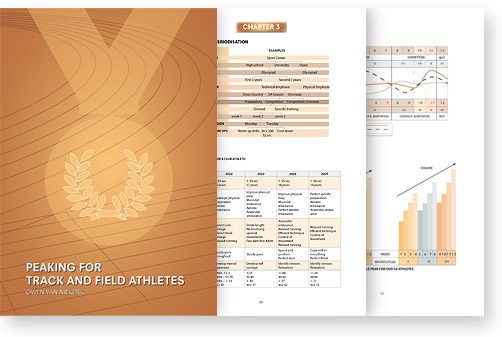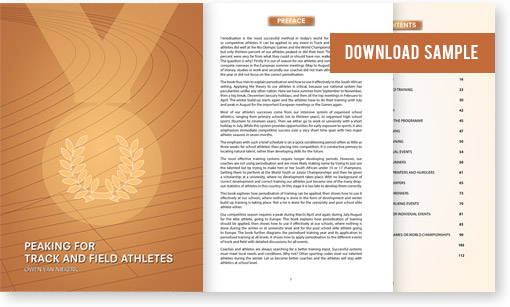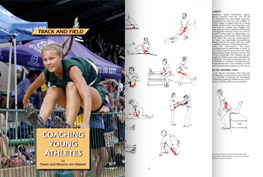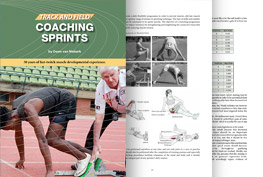Peaking for Track and Field Athletes

Overview
 Purchase our ebook below for access to immediate download.
Purchase our ebook below for access to immediate download.
The book is provided in PDF format and licensed per user.
Payment is 100% secure. Please contact us for technical
support queries.
Periodisation is the most successful method in today’s world for organizing, training or competitive athletes. It can be applied to any event in Track and Field. South African athletes did well at the Rio Olympic Games and the World Championships in London 2017, but only thirteen percent of our athletes peaked or did their best. The other eighty seven percent were very far from what they could or should have run, walked, jumped or threw. The question is why? Firstly it is out of season for our athletes and some of them could not compete overseas in the European summer meetings (May to August), because of the lack of money, studies or work and secondly our coaches did not train athletes properly during the year or did not focus on the correct periodisation.
The book explains periodisation and how to use it effectively in the South African setting. Applying the theory to our athletes is critical, because our national system has peculiarities unlike any other nation. Here we have summer from September to November, then a big break, December / January holidays, and then all the top meetings in February to April. The winter build-up starts again and the athletes have to do their training until July and peak in August for the important European meetings or the Games again.
Most of our athlete’s successes come from our intensive system of organised school athletics, ranging from primary schools (six to thirteen years), to organised high school sports (fourteen to nineteen years). Then we either go to work or university with a short holiday in July. While this system provides opportunities for early exposure to sports, it also emphasises immediate competitive success over a very short time span with two major athletic seasons in seven months.
The emphasis with such a brief schedule is on a quick conditioning period (often as little as three weeks for school athletes) then placing into competition. It is conductive primary to locating natural talent, rather than developing skills for the future.
The most effective training systems require longer developing periods. However, our coaches are not using periodisation and are more likely making name by trying to just use the talented kid by trying to make him or her South African under 10 or 17 champions. Getting them to perform at the World Youth or Junior Championships and then be given a scholarship at a university, where no development takes place. With no background of correct development and correct training our athletes just became one of the many drop-out statistics of athletes in this country. At this stage it is too late to develop them correctly.
This book explores how periodisation of training can be applied, then shows how to use it effectively at our schools, where nothing is done in the form of development and winter build up training is taking place. Not a lot is done for the university and post school elite athlete either.
Our competitive season requires a peak during March/April and again during July/August for the elite athlete, going to Europe. This book explains how periodisation of training should be applied, then shows how to use it effectively at our schools, where nothing is done during the winter or at university level and for the post school elite athlete going to Europe. The book further diagrams the periodised training year and its application to periodised training at all levels. It shows how to apply periodisation to the different events of track and field with detailed discussions for all events.
Coaches and athletes are always searching for a better training input. Successful systems must meet local needs and conditions. Why not? Other sporting codes steel our talented athletes during the winter. Let us become better coaches and the athletes will stay with athletics at school level.
Table of Contents
Chapter 1 Periodisation and the South African System
Chapter 2 Periodisation: Its Meaning and Value
Chapter 3 The Language of Periodisation
Chapter 4 The Principles of Training
Chapter 5 The Planning of Periodised Training
Chapter 6 Planning the Year
Chapter 7 Challenges for the Coach
Chapter 8 Applying Periodisation to the Programme
Chapter 9 Periodised Strength Training
Chapter 10 Periodised Plyometric Training
Chapter 11 Periodisation for Individual Events
Chapter 12 Periodised Training for Runners
Chapter 13 Periodised Training for Sprinters and Hurdlers
Chapter 14 Periodised Training for Jumpers
Chapter 15 Periodised Training for Throwers
Chapter 16 Periodised Training for Walking Events
Chapter 17 Fitness Characteristics for Individual Events
Chapter 18 Training Phases
Chapter 19 Peaking for the Olympic Games or World Championships
Chapter 20 Peaking the Mind
Chapter 21 References
Download a free sample
Download the first few pages of the book here as a preview:
Price
$ 15.00 (approximately R270.00)
Featured Books
Track and Field Coaching Young Athletes
by Owen and Maryna van Niekerk
This book is for coaches, teachers and parents who have young athletes in their school or training groups. The book provides many well illustrated activities to use for the selection of young athletes for further coaching. A series of drills and coaching tips, suggestions for planning programmes, and methods for improving the level of safety are provided.
Featured Books
Track and Field Coaching Sprints
by Owen van Niekerk
This book is for coaches, parents, sprinters and all the young beginners, to study the correct art of sprint training, to improve their athletic ability and natural talent. To become a world class sprinter the athlete should first be identified, tested and only then developed in the correct way.







